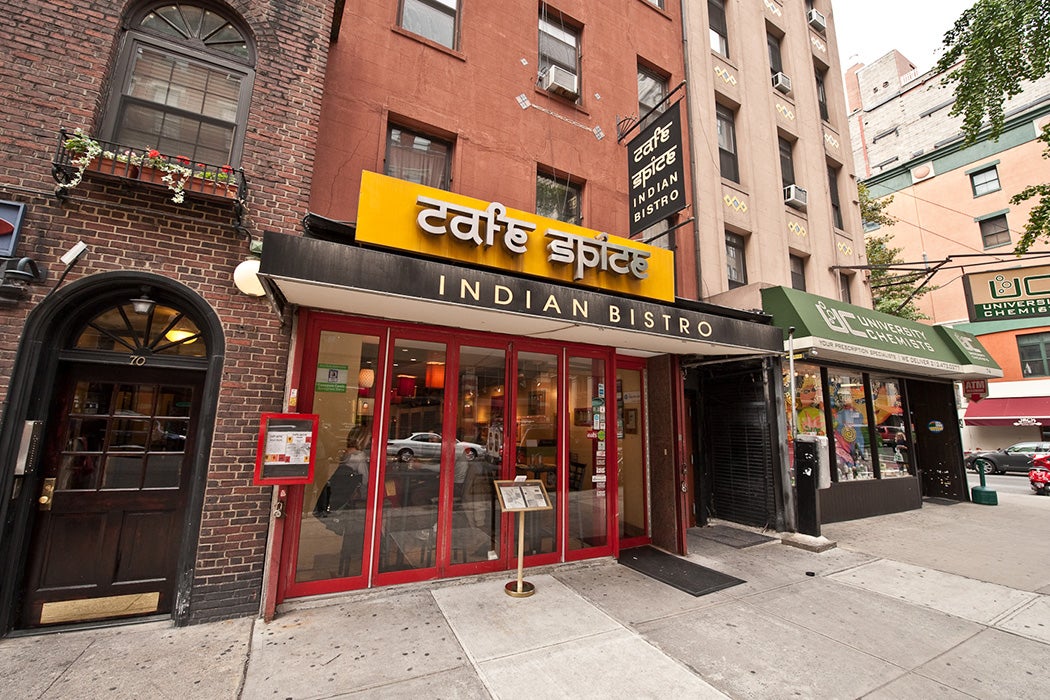What’s in a restaurant name? How can a business appeal to locals? Immigrants setting up shop in a new city have to be savvy entrepreneurs to figure these problems out—in fact, almost like amateur anthropologists in the field, proposes sociologist Krishnendu Ray.
Ray suggests that recent scholarly work has “produce[d] a peculiarly constricted immigrant subject as only laboring” rather than as a creative cultural participant. But immigrants clearly take part in “the aesthetics of work,” he argues, “through their naming of restaurants, designing menus, and reproducing foods, flavors, and ambience in the metropolis.” In doing so, argues Ray, the immigrant entrepreneur becomes an “inverted anthropologist” who is able to expose aspects of local culture that other inhabitants of the city may not notice.
For his project, Ray visits a small eatery on a rundown corner “at the lower end of Manhattan” called Bread & Butter, which Pakistani proprietor Muhammad Rasool simply describes as a “fast-food restaurant.” From Ray’s description, Bread & Butter is a tiny space, with room for just sixteen diners. Rasool and his two workers dish pre-cooked items from a steam table onto Styrofoam plates.
Rasool, who drove a taxi for more than a year to save up for his restaurant, repeatedly tells Ray that “[i]t does not take a genius” to cook the “Indian, Pakistani spicy food” or “less spicy Spanish-American food” that he serves. “It is business. It is only business,” he asserts. “It is not real.”
His “insistence that what we have here is mere commerce and not culture” is widely shared by South Asians, with Ray noting that “the presumed realm of culture” is women’s home cooking. Indeed, Rasool is aware that his business needs to have local market appeal. His “Spanish-American” fare—rice, beans, chicken—is “the same food without spices” as his South Asian dishes.
“Here is Rasool reorienting himself to his specific Latino public at that street corner, as fewer and fewer South Asian taxi drivers … stop by his place,” Ray explains.
Yet, when Ray asks him what his dream restaurant would look like, Rasool fantasizes replacing a mirrored wall with pictures of iconic landscapes from Pakistan. Ray transcribes the details of the dream. “I will sell cheap soup,” Rasool promises,
self-service soup, pita bread, and put a grill there [at the window to the sidewalk]; serve shawarma, chicken shawarma, lamb shawarma. I will put the clay oven—the tandoor—there. I will get a young guy with a cap [toque] on his head. We will just have meats in the tandoor, salads and soups. I will call it Pakistani Grill! If I was permitted in Islam to sell liquor, maybe as an exception, I would open a big restaurant…still an Indian Pakistani place but beautiful like an American place.
In other words, writes Ray, “Rasool would rebuild his corner of the city” and “turn this into a generic Middle Eastern place, at some distance from South Asia, but successfully playing between the scope of his ecumenical Islamic imagination and the confused compass of his audience’s geography.”
Unlike Chinese restaurants that historically catered to Chinatown residents, South Asian restaurants in the United States have typically had to be “outwardly directed,” notes Ray.
“Until the last quarter of the twentieth century, the Indian population in the United States was too small and dispersed to support enclave eateries such as we find among the Chinese,” he writes. As such, South Asian immigrant entrepreneurs had to bestow on their restaurants names recognizable to cultural outsiders. New York City’s first recorded South Asian restaurant, which opened in 1913, was Ceylon India Inn, for example, and eateries included “India” in their name for decades.
“[B]y the end of the 1960s, subnational places and nonplace names were added to the repertoire, such as Punjab, Karachi, Rajmahal, Koh-i-Noor, and Natraj,” Ray adds. “Yet, clear national identifiers had to be positioned in small print underneath the names, such as ‘unique Pakistani, Indian cuisine’ under Rajmahal or ‘Authentic Indian Curries’ under Punjab.”
In fact, Rasool renamed his business out of necessity.
“I used to call it Taj Mahal, but my business was not working,” he says, which he suspects was because “[n]o one…knows what Taj Mahal is.”
Weekly Newsletter
Ray argues that the ignorance attributed to would-be local diners reveals “the mercurial nature of power in the encounter between the customer, the server, and the [immigrant] entrepreneur.”
Previous studies about the consumption of ethnic food “have given too much power to the customer and critic in the process of meaning-making,” he writes. But “[t]he foreign-born have always participated in the negotiations, not as equal partners, but as substantial ones.”







